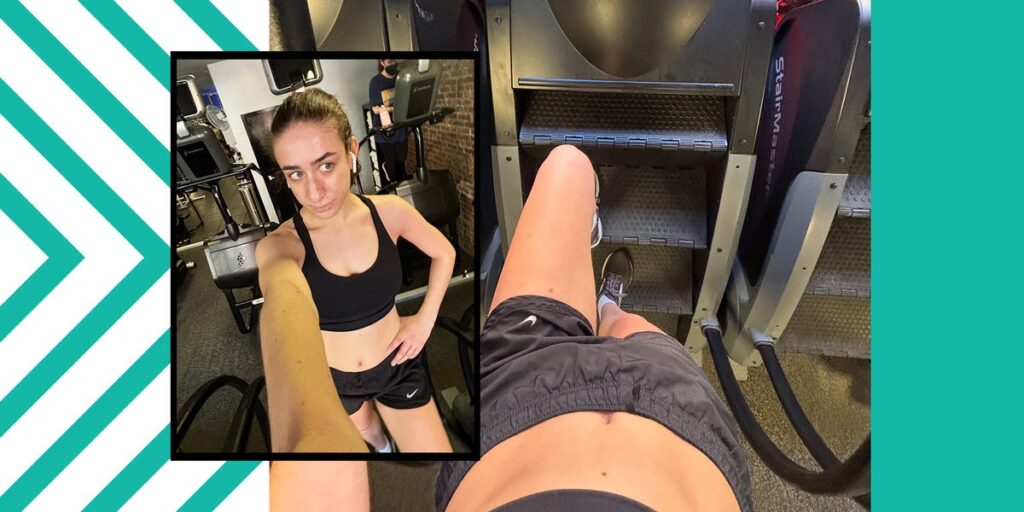Upon settling into New York City and acquiring a gym membership, I was surprised to notice the numerous fellow gym enthusiasts gravitating towards the stair climber. Living in a walk-up apartment, the act of climbing stairs felt more like a mundane chore than a workout I would choose to engage in during my free time. Yet, after witnessing the hype surrounding the viral 25-7-2 StairMaster workout and observing the high traffic at the stair climber section, my perspective began to shift.
A bit of research highlighted the stair climber’s capabilities in enhancing cardiovascular endurance and leg strength. It also offers a lower-impact workout, which is gentle on the joints—a convincing factor for someone like me, diagnosed with inflammatory arthritis at 21. Thus, I made it my mission to transform this everyday task into a workout challenge, aiming for 15 minutes on the stair climber each day for two weeks.
As a novice to the stair climber, I sought guidance from Gabrielle Savary, CPT—a professional bodybuilder and head coach at Grow With Gab Fitness, recognized in WH’s Strength in Diversity class of 2024. She reassured me that both seasoned athletes and fitness novices could gain benefits from stair climbing. It engages multiple muscle groups simultaneously, including calves, hamstrings, quads, and core, making it an efficient workout. Plus, with the ability to adjust the level and speed of the stairs, it’s easy to tailor your workout to your pace.
Expert Insights: Gabrielle Savary, CPT, is a professional bodybuilder and head coach at Grow With Gab Fitness, also part of WH’s Strength in Diversity class of 2024.
“The stair climber presents a unique cardiovascular challenge compared to treadmills or ellipticals,” Savary explains. Each step involves working against gravity, which elevates the heart rate; yet, it remains low-impact—perfect for those avoiding the tough nature of running.
I wouldn’t classify myself as a gym rat—in fact, I prefer the outskirts and usually stick to a familiar routine of treadmill, weights, and core exercises. My fitness goals include running five miles and developing enough core and leg strength for ballet classes. I was hopeful that incorporating the stair climber into my routine would aid in reaching my objectives—and spoiler alert: it did!
Alexa, please play “Running Up That Hill.”
My Journey on the Stair Climber
During my stair climber challenge, I experimented with various techniques: maintaining a consistent speed, gradually increasing the speed, and incorporating intervals. Ultimately, I settled on a regimen with five minutes of warm-up and ten minutes of varying intensity, which proved the most engaging.
Honestly, the first day was a lot to handle. I jumped straight into level eight, a rookie error that left me breathless and drenched in sweat. I had to pause multiple times throughout the 15 minutes. Despite my legs feeling like jelly afterward, I surprisingly didn’t experience significant soreness the following day, allowing me to continue my workouts without issue. Other than a minor ache in my glutes and hips, my body held up well. (Throughout the two weeks, soreness mainly appeared on days when I combined stair workouts with lifting sessions.)
By days two to six, I adapted to levels six and seven, gradually building the stamina to tackle higher levels after extended warm-ups. I realized that maximizing the stair climber experience is as much a mental challenge as it is a physical one. Listening to music that matched my pace made the workout enjoyable, and covering the screen with a t-shirt helped me forget how long I had been on the machine.
Form Tips: Keep your chest upright, core engaged, and arms relaxed for proper form, advises Savary. Resist the temptation to hunch over the rails; if you need assistance, maintain a light grip while keeping your posture aligned.
By the seventh day, I could comfortably alternate between levels nine, ten, and eleven for a few minutes before returning to six and seven—an achievement that felt far from my initial struggles. The workouts started feeling enjoyable, transforming 15 minutes into what felt like merely five. By the end of my two-week challenge, I noted considerable improvements in both my physical capabilities and mental fortitude.
Transformations from Two Weeks on the Stair Climber
1. Enhanced Cardiovascular Endurance
Each stair climber session made the workout progressively easier, and I noticed the endurance I developed translating into my running routine. Post-challenge, my regular three-mile loops felt significantly more manageable, and less strenuous, even on uphill sections.
Stair climbing is linked to numerous health benefits, including a lowered risk of heart disease, alongside improved glucose and cholesterol levels, according to a 2024 study published in the Journal of Cognitive Enhancement.
2. Increased Leg Strength
Just a few days into the challenge, I began feeling stronger in my calves, hamstrings, and glutes. In my weekly ballet class, I was able to maintain my leg positions longer at the barre and reduced the typical post-class soreness I experienced.
My leg muscles, especially my calves, appeared more toned and defined. Savary clarifies that while stair climbing alone doesn’t induce muscle growth, it complements strength training. Using it as a warm-up can amplify leg day results, which I found to be true during my experiment.
“Incorporating the stair climber before leg workouts enhances blood flow to the target muscles, allowing for better growth,” Savary asserts.
3. Better Management of My Chronic Condition
Living with arthritis poses unique challenges, often making running or lifting a struggle. The stair climber has become an integral part of my workout regimen, enabling me to improve endurance and cardiovascular health on days I don’t feel my best.
On stiffer days, engaging in 15 minutes—even at lower intensities—left me feeling more limber and relaxed post-workout. Moreover, the exercise served as a mental refresher, lifting my spirits on difficult days and leaving me feeling happier and more at ease.
4. Growth in Mental Resilience
The stair climber was, quite literally, an uphill battle; it challenged me, yet I persisted. This experience reminded me of the importance of facing challenges with a positive attitude, both in the gym and beyond.
For me, the stair climber served as a dual warm-up—physically and mentally. Mastering the machine gifted me with a sense of empowerment, affirming that if I can succeed against gravity for an extended time, I can conquer any challenge. Furthermore, research supports that stair climbing can enhance mood and cognitive ability, as highlighted in the 2024 study.
This challenge prompted me to reassess my self-talk regarding fitness: I often claim, “I’m not a runner” or “I’m not a lifter.” But if I run regularly, I am indeed a runner; if I lift consistently, then I am a lifter. By regularly engaging in stair climbing, I confidently declare myself a StairMaster master. And if I can embark on this journey, so can you!


